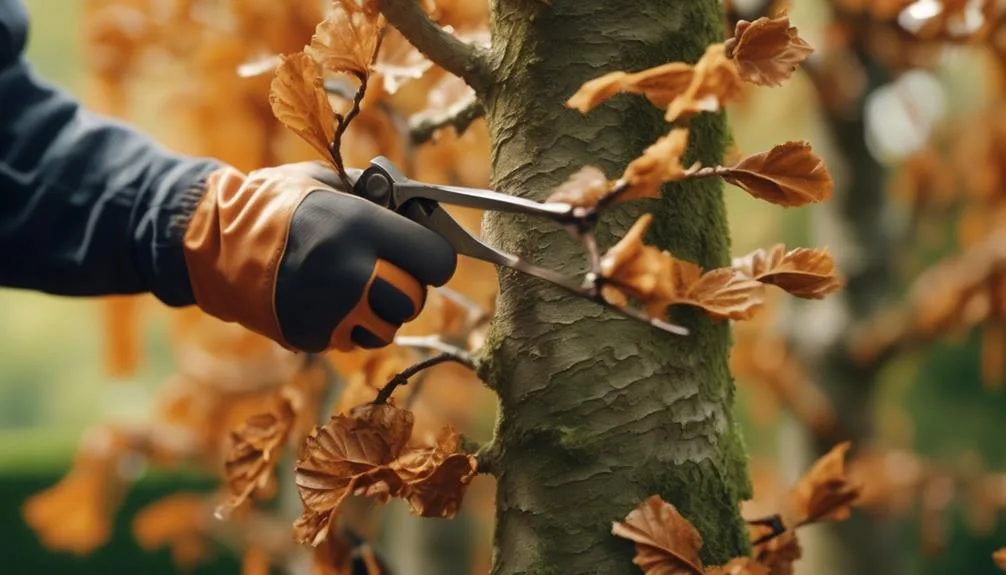Wondering if beech trees can be shaped and trained to your liking?
The possibility of manipulating their growth for aesthetic purposes is an intriguing topic in horticulture and landscape design. We'll explore the potential for shaping and training these trees, uncovering the techniques and considerations involved.
Join us to discover the art and science of working with beech trees to achieve your desired outcome.
Beech Trees: Natural Growth Patterns
Understanding the natural growth patterns of beech trees is crucial for successfully shaping and training them to fit your desired aesthetic and functional purposes. Beech trees are renowned for their natural beauty, characterized by their smooth, silver-gray bark and vibrant, green leaves that turn golden in the fall.
The growth pattern of beech trees typically involves a broad, spreading crown with branches that gracefully arch downwards. This unique growth habit makes beech trees ideal for providing shade and privacy in a garden or landscape. Additionally, their growth patterns make them suitable for shaping into elegant hedge rows or standalone specimens.
Pruning Beech Trees: Techniques and Considerations
When pruning beech trees, it's essential to carefully consider the techniques and timing to ensure the health and aesthetic appeal of the tree.
Beech tree pruning offers several benefits, such as promoting a strong structure, removing dead or diseased wood, and enhancing the overall appearance.
However, there are also drawbacks to be mindful of, including the potential for beech trees to be sensitive to pruning, which may lead to slow healing and susceptibility to diseases.
To maintain the aesthetic appeal of beech trees, it's crucial to prune selectively, avoiding excessive removal of branches that can result in an unnatural or unbalanced appearance.
Additionally, timing is critical, as pruning during the dormant season can minimize stress on the tree.
Careful consideration of these factors will help you achieve the desired results when shaping and pruning beech trees.
Training Young Beech Trees: Methods and Best Practices
To shape and train young beech trees effectively, employing proper techniques and best practices is crucial for their long-term health and overall development. When it comes to young tree training, there are several methods and best practices to keep in mind:
- Stake Young Trees: Use stakes to provide support and stability to young beech trees, especially in windy areas, to encourage straight and upright growth.
- Prune Carefully: Regularly prune young beech trees to remove dead or damaged branches, promote a strong framework, and shape the tree according to your desired form.
- Mulch and Water: Apply mulch around the base of the tree to retain moisture and suppress weeds, while ensuring the tree receives adequate water, especially during dry periods.
- Monitor Growth: Regularly monitor the growth of young beech trees to identify any issues early on and make necessary adjustments to their training regimen.
Shaping Mature Beech Trees: Tips for Success
Shape mature beech trees with careful pruning and strategic training to maintain their health and enhance their aesthetic appeal.
When shaping mature beech trees, consider the artistic vision you have for your landscape. Pruning techniques for mature beech trees should be focused on removing dead or diseased branches, as well as any crossing or rubbing limbs that may hinder the overall form. This will allow for better air circulation and sunlight penetration, promoting the tree's health.
Additionally, selective pruning can help accentuate the natural beauty of the mature beech tree, creating a visually appealing silhouette.
When training these trees, consider using stakes or guides to encourage specific growth patterns.
Maintaining Shaped Beech Trees: Long-Term Care Essentials
Curious about how to ensure the long-term health and beauty of your shaped beech trees? Proper maintenance is essential for preserving the form and vitality of your trees.
Here are some crucial long-term care essentials to keep your beech trees in optimal condition:
- Yearly maintenance: Regularly inspect your shaped beech trees for any signs of disease, pest infestations, or structural issues. Addressing these issues promptly can prevent them from escalating and causing significant harm to the trees.
- Pruning: Continue to prune your beech trees as they grow to maintain the desired shape and size. Be mindful of the tree's natural growth patterns while shaping it.
- Shaping tools: Use high-quality, sharp pruning tools to ensure clean cuts and minimize stress on the trees.
- Soil care: Monitor the soil moisture and fertility levels to provide the necessary nutrients for the trees' long-term health and growth.
Conclusion
Incorporating the right techniques and care, shaping and training beech trees is achievable. By understanding their natural growth patterns, employing proper pruning methods, and providing ongoing maintenance, you can enjoy well-shaped beech trees in your outdoor space for years to come.
How will you shape your beech trees to complement your landscape?

My interest in trees started when I first saw the giant sequoias in Yosemite.
I was a teenager then, and I remember thinking, “I need to learn more about this.”
That moment stuck with me.
A few years later, I went on to study forestry at Michigan Tech.
Since graduating, I’ve worked in a mix of hands-on tree care and community education.
I’ve spent over ten years helping people understand how to plant, maintain, and protect the trees in their neighborhoods.
I don’t see trees as just part of the landscape.
They are living things that make a real difference in our daily lives.
